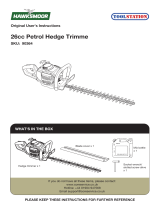Using your brushcutter
ENGLISH 14
8. Using your brushcutter
8.1 Scope of Application
Only use brushcutters equipped with a nylon head
(subject to model) for cutting grass – particularly
suitable around obstacles - and for trimming light
weeds and wild growth near ground level. The
nylon head is particularly suitable for a soft cut, e.g.
for clean trimming around trees and posts.
Use brushcutters equipped with the grass cutter
blade (subject to model) only for cutting grass away
from obstacles and for cutting stronger weeds and
wild growth near ground level.
As standard model, the brushcutter is unsuitable for
any other purpose. Cutting light brush, reeds, tough
grass and strong weeds near ground level is only
permitted with the steel thicket blade (SOLO part
no. 69 00 947), which is available as accessory.
Using the cutting tools, which are available as
accessories and which are specified for certain tasks,
enable the brushcutter to be used for those
purposes specifically mentioned in the accessory
instructions. Also observe the safety instructions in
those accessory instructions.
Generally, use only the cutting tools authorised for
use with this brushcutter. Always fit the contact
shield specified for this brushcutter and cutting tool.
If in doubt, contact your local SOLO dealer.
8.2 Correct brushcutter operation
Observe the relevant safety instructions when using
the brushcutter.
The rotational direction of the cutting tool makes
the operation on the l.h. side of the cutting tool
(from the operator's viewpoint, subject to the
brushcutter being held correctly) particularly free
from kicking. Therefore, always approach the area
to be cut from the right. This brings the l.h. side of
the cutting tool into contact with the material to be
trimmed first. Particularly when cutting tougher
growth (such as medium sized weeds and wild
growth) with a grass cutter blade, ensure that you
do not "stab" the front of the brushcutter into the
material to be trimmed.
Approach the working area with the brushcutter set
to idle, and then switch to full throttle. Never leave
the engine running at high speed without applying
a load.
Dip the tool from the r.h. side 2/3 into the material
to be trimmed. Then work the brushcutter lie a
scythe, i.e. by moving forward step by step, whilst
cutting from right to left.
Operate the brushcutter at full throttle to obtain an
optimum cutting result. Never operate with the
clutch in slipping range. Consequential damage
through excess loads or overheating is excluded
from our warranty.
Immediately stop the engine in case of noticeable
vibrations or when material has gathered around
the cutting tool or contact shield. Slow down the
cutting tool by pressing it onto the ground, until it
has come to a complete standstill. Pull the spark
plug cap from the plug, and clean the tool seat of
all grass, roots etc. Check the entire brushcutter for
perfect condition.
When using the nylon head, always ensure that you
operate only with the correct length of line. When
the contact shield is fitted, the line will always be
trimmed to the permissible length automatically (a
line trimming blade is fitted into the shield). There is
a high risk of injury, and the engine is subjected to
excessive loads leading to a risk of damage, if nylon
lines are left too long.
Therefore, when converting the cutting tool from
grass cutter blade to nylon head, always fit the
standard contact shield together with the protective
bar and fitted line trimming blade.
Fig. 13




















